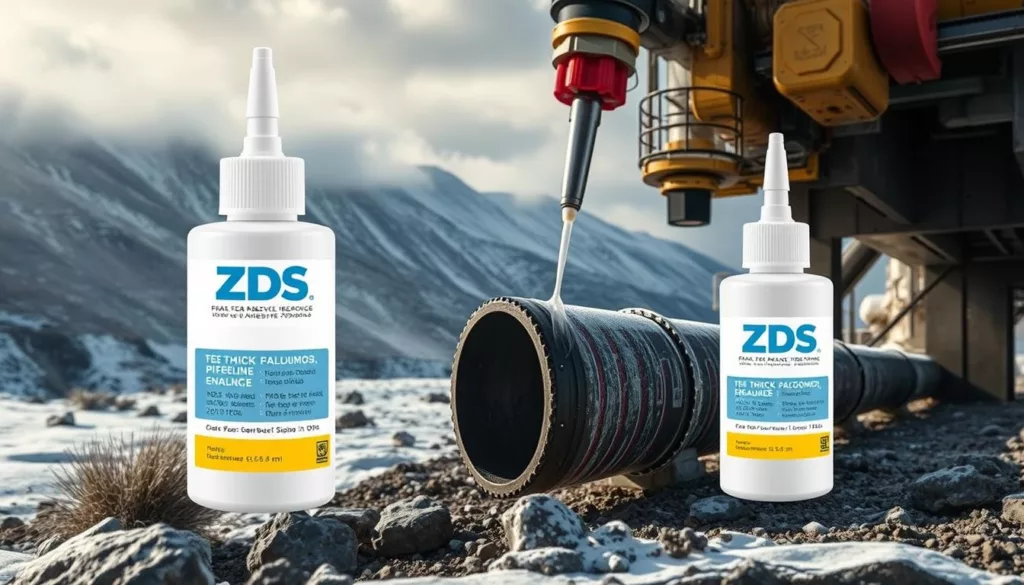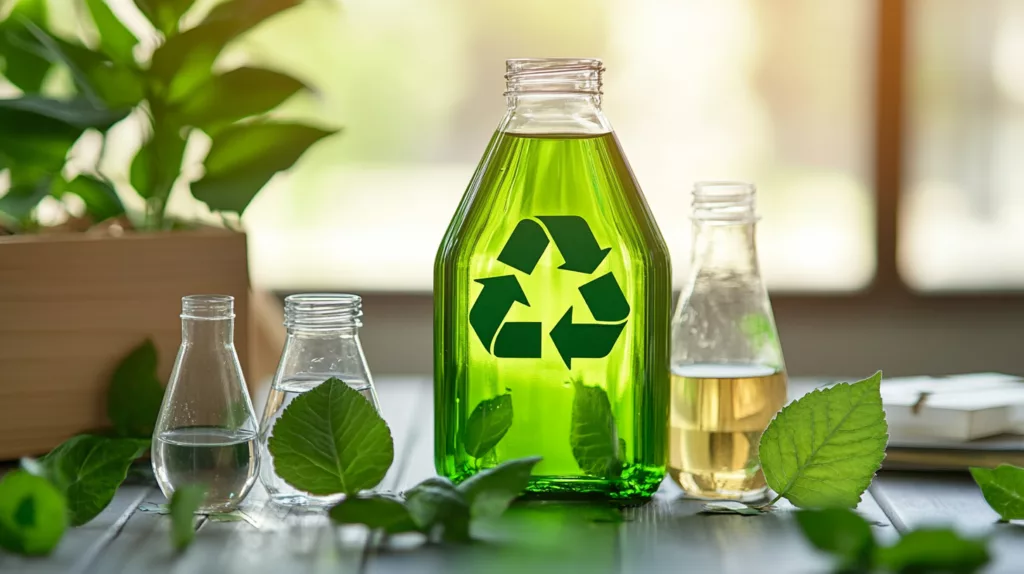In the demanding world of petroleum, keeping pipelines safe in tough weather is key. Choosing top adhesives for these conditions affects efficiency, safety, and reliability. The right pipeline adhesive solutions are vital under changing temperatures and moisture. Knowing about adhesives and how to use them improves performance.
This guide covers different adhesives for petroleum pipelines in extreme weather. We’ll look at bond strength, viscosity, and drying time to help you pick wisely. Smart choices increase durability, save money, and might boost safety for your pipelines.
Key Takeaways
- Selecting the right adhesive is vital for pipeline integrity in adverse conditions.
- Epoxy, polyurethane, and silicone adhesives serve specific purposes in pipeline applications.
- Understanding temperature resistance and chemical compatibility is essential.
- High-quality adhesives can lead to enhanced durability and safety.
- Regular inspections and maintenance are crucial for ensuring adhesive integrity.
Introduction to Petroleum Pipeline Adhesives
In petroleum pipeline construction and maintenance, choosing the right adhesive is vital. It determines the system’s safety and functionality. High-quality adhesives make pipelines safer and more reliable, especially under various conditions. They prevent leaks and structural issues, avoiding costly and dangerous outcomes.
Importance of Choosing the Right Adhesive
Choosing the best adhesive is key for petroleum pipelines’ success. A bad choice can cause many problems, like:
- Structural Integrity Challenges: Poor bonding can lead to unreliable pipelines.
- Chemical Compatibility Issues: Some adhesives can’t handle the chemicals in petroleum.
- Temperature Resistance: Adhesives must work well in very hot or cold climates.
It’s critical to pick adhesives made for tough settings. For more on how adhesives react under stress, see our analysis of epoxy adhesive performance at high.
Overview of Harsh Climate Conditions
Petroleum pipelines face tough climates, bringing many challenges. Adhesive performance can be impacted by:
- Extreme Temperature Fluctuations: Intense heat can weaken adhesives.
- Corrosive Environments: Natural elements can erode adhesives chemically.
- Physical Stress Factors: Adhesives need to be strong to handle high pressure.
Knowing these conditions helps choose the right adhesives for harsh climates. This ensures pipelines last longer and perform better.
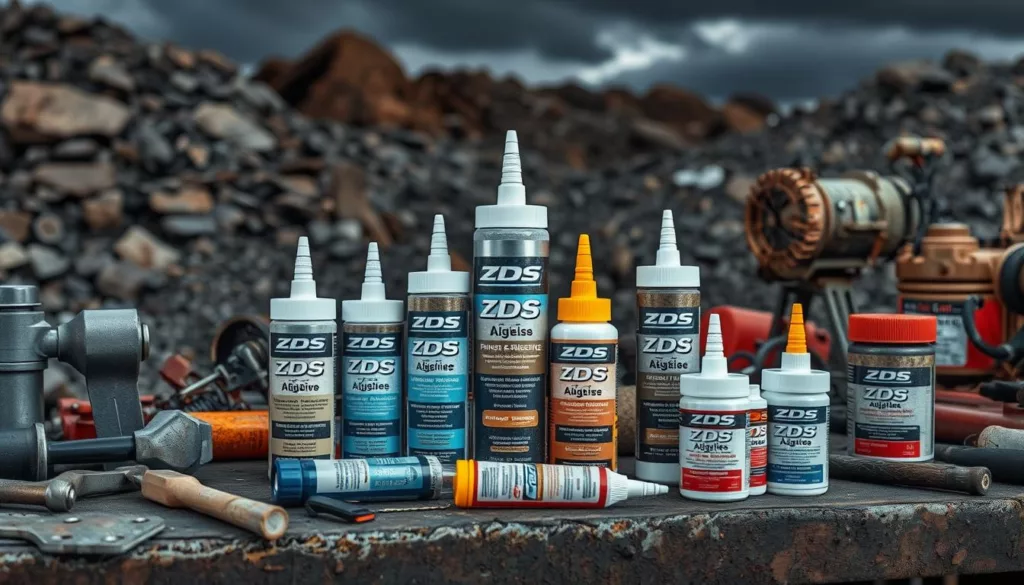
Types of Adhesives Suitable for Petroleum Pipelines
Choosing adhesives for petroleum pipelines needs a deep dive into their types and benefits. We’re looking at three key types: epoxy, polyurethane, and silicone adhesives. Each brings unique qualities to the table, making them stand out for pipeline use, especially in challenging conditions.
Epoxy Adhesives
Epoxy adhesives are known for their strength and durability in pipelines. They bond strongly and can handle tough environments. This includes changes in temperature and exposure to chemicals. Their features are:
- High tensile and shear strength.
- Excellent resistance to solvents and moisture.
- Long curing time allowing detailed work during application.
Polyurethane Adhesives
Polyurethane adhesives shine when flexibility and resilience are needed. They stretch and move, perfect for changing pressures and conditions. They offer:
- Good adhesion to various surfaces.
- Elasticity for joint movement.
- Water and chemical resistance.
Silicone Adhesives
Silicone adhesives can handle extreme temperatures and remain flexible. Ideal for tough conditions, they seal against moisture and temperature variations well. Their key features are:
- Great flexibility across temperatures.
- Strong resistance to UV and aging.
- Safe for diverse pipeline uses.
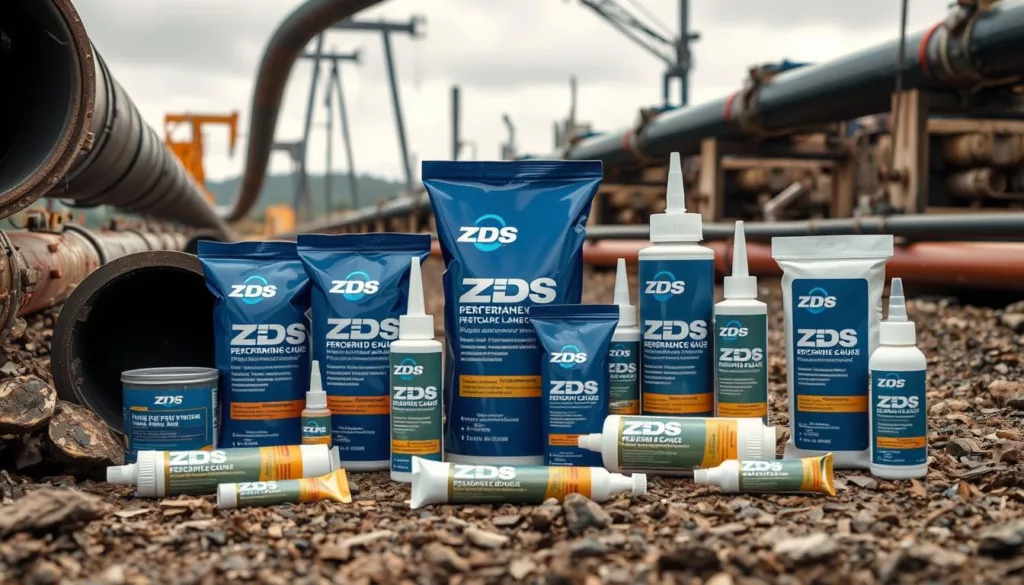
Choosing the right adhesive for pipelines relies on knowing these types and how they work. Each adhesive mentioned plays a crucial role. They help maintain and protect petroleum pipelines in different conditions.
| Adhesive Type | Strengths | Applications |
|---|---|---|
| Epoxy | High strength, solvent resistance | Structural bonding, repair |
| Polyurethane | Flexibility, adhesion to various surfaces | Sealing joints, dynamic applications |
| Silicone | Temperature resistance, UV stability | Weatherproofing, sealing |
Key Considerations for Selecting Adhesives
When picking adhesives for petroleum pipelines, you should consider several factors. These aspects have a big impact on how well the adhesive works. They also affect its longevity in tough environments and extreme climates.
Temperature Resistance
How well an adhesive can handle temperature changes is very important. Adhesives that are used in extreme climates must handle both hot and cold temperatures. Understanding the temperature ranges helps in choosing the best adhesive.
Chemical Compatibility
Assessing if the adhesive works well with certain chemicals is critical. Petroleum products have different chemicals that could weaken the adhesive. It’s important to choose adhesives that are made to resist these chemicals. This ensures a strong bond and reduces failure risks.
Environmental Impact
Today, it’s key to think about the environment when selecting adhesives for petroleum pipelines. Opting for sustainable adhesives helps lessen the carbon footprint. It also ensures compliance with regulations. Choosing green options benefits both pipeline performance and our planet.
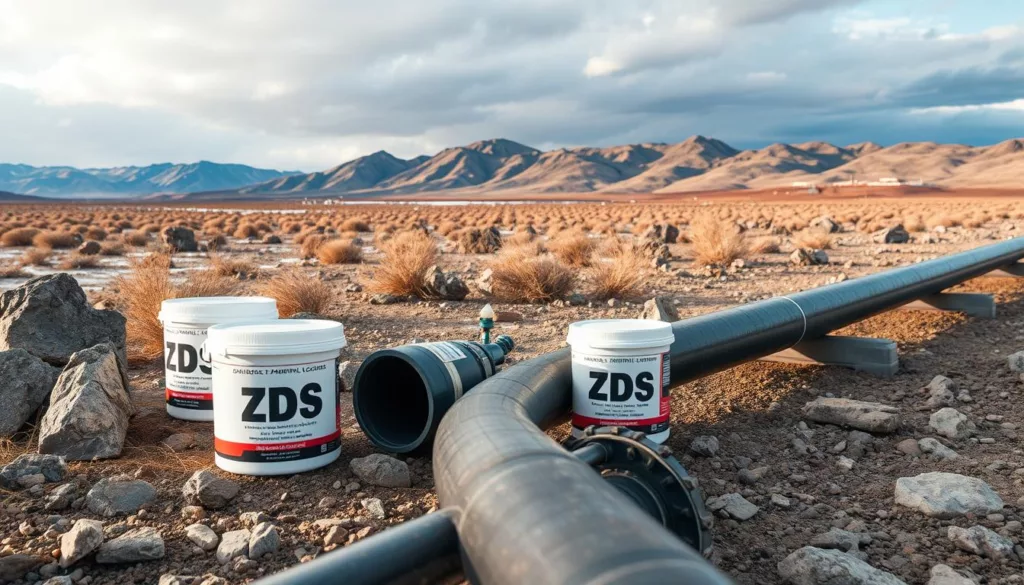
Leading Brands in Pipeline Adhesives
In the pipeline adhesive market, some brands stand out. They are known for innovative technology and reliable performance. It’s crucial to know these leaders for choosing the best pipeline adhesives for tough conditions.
3M
3M is known for its advanced adhesive solutions. They offer a wide range of high-performance adhesives. These products are perfect for demanding situations. 3M is a pioneer in innovation. Their adhesives work well and last long, even in extreme weather.
Henkel
Henkel combines high performance with care for the environment. They do not sacrifice quality for eco-friendliness. Henkel makes excellent adhesives for petroleum pipelines in harsh climates. Their products are tough and endure tough environmental conditions.
Loctite
Loctite is famous for reliable industrial adhesives. They are known for their strong and flexible bonding solutions. Loctite’s products meet the challenges of pipeline projects. They ensure strong bonds, making them ideal for petroleum pipeline applications.
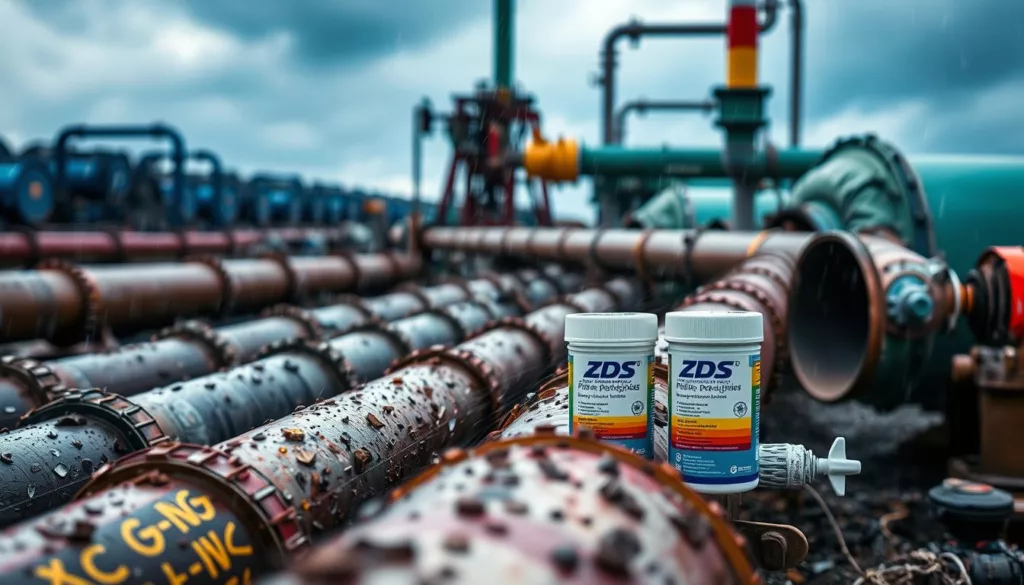
| Brand | Key Features | Applications |
|---|---|---|
| 3M | Innovative technology, excellent adhesion | Pipeline repair, construction |
| Henkel | Sustainable practices, high performance | Petroleum pipelines, industrial uses |
| Loctite | Strong, versatile bonding | General industrial, harsh environments |
Benefits of Using High-Quality Adhesives
Choosing top-notch petroleum pipeline adhesives has many advantages. They improve performance and reliability. These include longer-lasting results, saving money, and better safety, crucial for keeping pipelines secure in tough environments.
Enhanced Durability
Top-grade adhesives resist harsh conditions well. Using strong pipeline adhesive solutions means less damage over time. This strength helps prevent breakages, making pipelines last longer.
Cost-Effectiveness
Going for dependable petroleum pipeline adhesives is a smart financial move. Even though they cost more upfront, you save more by not needing as many repairs. This choice boosts the efficiency of your operations.
Improved Safety
Using superior adhesives makes workplaces safer. It lowers the chance of leaks and failures, promoting a safer setting. Better safety protects materials and everyone working with pipelines.
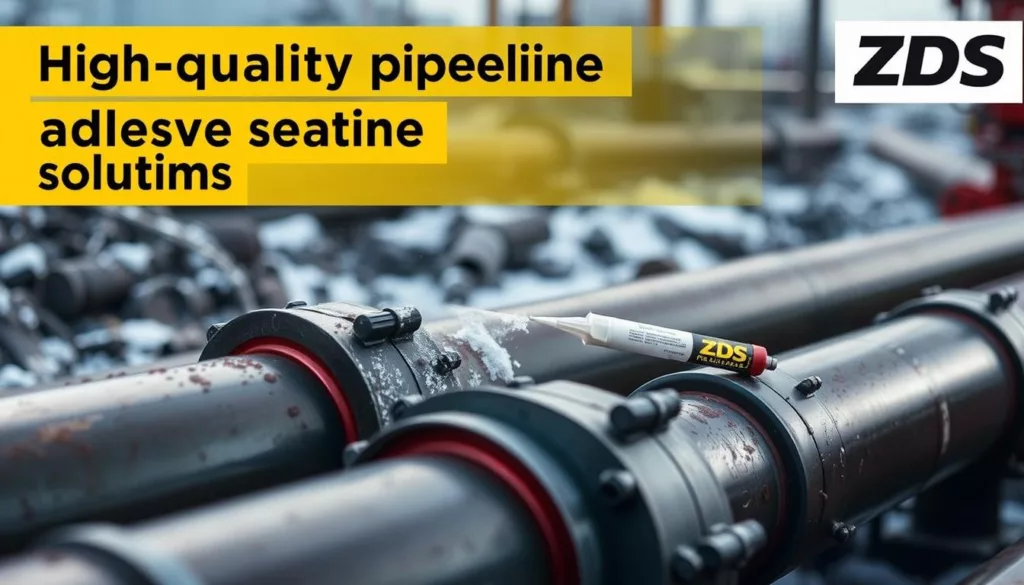
Common Challenges in Harsh Climates
Working with petroleum pipeline adhesives needs an understanding of environmental impacts. Knowing the challenges helps create better solutions for harsh conditions. This leads to adhesives that work well in extreme environments.
Extreme Temperatures
Adhesives in pipelines face problems with extreme temperatures. High heat makes adhesives soft or too thick, making them less effective. On the other hand, very low temperatures can make them brittle and cause cracks or breaks.
It’s important to use adhesives that can handle these temperature changes. This ensures they perform reliably under different conditions.
Moisture and Humidity
Moisture and humidity are big issues for petroleum pipeline adhesives. Too much moisture weakens the bond and can lead to failures. It also makes metal parts corrode faster.
Choosing adhesives that resist moisture helps keep the bond strong. This is crucial in places with a lot of water exposure.
UV Radiation
UV radiation greatly affects how long adhesives last in pipelines. It can weaken some adhesives, making them less elastic or strong. Using adhesives that resist UV ensures they keep working well, even in sunlight.
| Challenge | Impact on Adhesives | Solutions |
|---|---|---|
| Extreme Temperatures | Causes softening or brittleness | Use high-temperature resistant adhesives |
| Moisture and Humidity | Weakens bond and promotes corrosion | Employ moisture-resistant formulations |
| UV Radiation | Degrades adhesive properties | Choose UV-resistant adhesive types |
Application Techniques for Pipeline Adhesives
To get the best out of pipeline adhesives, you need to know how to apply them well. Doing things right ensures they work strong, even in tough places.
Surface Preparation
Getting the surface ready is key for a good stick. A clean and prepared surface leads to a firmer bond. Follow these tips to boost how well your adhesive works:
- Remove dirt, oil, and contaminants through cleaning agents or solvents.
- Roughen surfaces as needed to improve mechanical interlocking.
- Ensure all moisture is eliminated, particularly in outdoor settings.
Application Methods
Picking the right way to apply adhesive is crucial. You have options like:
- Manual Dispensing: Great for small jobs, gives you more control.
- Automated Dispensing: Best for lots of work, ensures even application and less waste.
Using the best technique can make your pipeline adhesives more effective.
Curing and Setting Time
The time adhesives take to cure and set affects bond strength. Knowing this helps plan your work:
- Think about how the weather can change the curing time.
- Adhesives have different setting times. Check the data sheets for advice.
For deeper understanding of structural acrylic adhesives, check out this resource.
Case Studies: Successful Adhesive Applications
Adhesive use in the petroleum industry is crucial. These real-world cases show how the right adhesives make pipelines more durable in tough conditions. They highlight the importance of choosing and applying adhesives wisely.
Project 1: Offshore Pipeline Repair
An offshore pipeline repair showed how advanced adhesives can be vital. In the sea, picking the right adhesive is key to fighting off saltwater and pressure. The chosen adhesive created a strong bond, keeping the pipeline in good shape and without leaks.
Project 2: Inland Oil Transport
The inland oil transport project points out the need for tough adhesives. These solutions kept the pipeline system sealed and secure, even on rough terrain and under changing temperatures. Thanks to these adhesives, the operation ran smoothly, boosting the system’s reliability.
Regulatory and Safety Compliance
Following rules and safety standards is key in the pipeline adhesives industry. This field has strict rules to keep petroleum pipelines working well, especially in tough climates. By adhering to standards like API 1104 and ASTM D1002, we select adhesives safely.
Overview of Industry Standards
Industry standards aim to lower risks when using adhesives in petroleum pipelines. They outline the qualities adhesives need to have. Important rules include:
- API 1104: It deals with welding pipelines and safe operation steps.
- ASTM D1002: It focuses on the strength of adhesive bonds, key for durability and integrity in pipelines.
Importance of Compliance in Harsh Climates
In tough environments, sticking to regulations for petroleum pipelines is more important. Using the correct adhesive prevents dangerous failures and leaks. Following rules helps:
- Enhancing Safety: It keeps people and the environment safe from risks.
- Maintaining Reliability: It makes sure pipelines work well throughout their life, despite tough conditions.
- Mitigating Environmental Impact: It avoids leaks that could damage ecosystems.
Maintenance Tips for Adhesive Integrity
Keeping pipeline adhesive systems working well is key to their efficiency. Proper upkeep ensures they last longer and reduces failure risks. We will talk about how to inspect them regularly and when to repair or replace them.
Regular Inspections
Regular checks help keep adhesive systems in good shape. They let us spot wear, environmental damage, or bonding issues early. Here’s what to do:
- Examine adhesive joints for deterioration.
- Assess surrounding conditions for extreme temperatures and moisture.
- Look for cracks, peeling, or other visible damage.
- Evaluate the compatibility of the adhesive with the materials it contacts.
Repair and Replacement Guidelines
It’s important to know when to fix or replace adhesives to keep pipelines safe. Here are some tips:
- Replace adhesive if significant degradation is visible.
- Consider repairing minor damages if the adhesive’s performance remains intact.
- Ensure that any repairs meet the original specifications for adhesive types.
- Keep detailed records of inspections and maintenance activities.
Good maintenance of pipeline adhesives requires being alert and taking action early. By inspecting often and making smart choices about repairs or replacements, we can keep our adhesive systems working well, even in tough conditions.
Conclusion: Choosing the Best Adhesive for Harsh Conditions
Picking the right adhesive for petroleum pipelines in harsh climates is not simple. It involves thinking about different things, like the weather and materials used. Knowing about different adhesives, how to apply them, and choosing quality products helps people make smart choices. This way, pipelines last longer and stay safe in tough places.
Finding the best adhesives for these situations means they have to meet high quality and technical requirements. By keeping these standards in mind, we can make pipelines safer and more efficient. For those looking for detailed advice on selecting top-performing adhesives, take a look at this resource.
In the end, having the right knowledge and focus is crucial. As we deal with extreme weather and conditions, choosing top-grade adhesive solutions is key. Doing so ensures that our pipeline operations are not only strong but also dependable for a long time.
FAQ
What are the best adhesives for petroleum pipelines in harsh climates?
The top choices for adhesives in harsh climates are high-performance epoxy, polyurethane, and silicone. They offer great strength and flexibility. This lets them handle extreme temperatures and tough conditions well.
Why is adhesive selection important for petroleum pipelines?
Choosing the right adhesive is key for pipeline safety and integrity. The wrong choice can cause leaks and failures. This affects both safety and operational efficiency. The right adhesives boost durability and the lifespan of pipelines.
How do harsh climate conditions affect adhesive performance?
Extreme weather and UV rays can lower adhesive effectiveness. It’s crucial to pick adhesives made to stand up to these conditions. This keeps the pipeline working well in tough environments.
What are some key considerations when selecting adhesives for petroleum pipelines?
It’s important to consider temperature resistance and chemical compatibility. The adhesive needs to handle extreme weather and not react with petroleum. This ensures the best performance.
Who are the leading brands for industrial adhesives for pipeline applications?
The leading brands include 3M, Henkel, and Loctite. They are known for high-quality adhesives for the petroleum industry. These brands offer reliable and innovative solutions.
What advantages do high-quality adhesives offer for petroleum pipelines?
High-quality adhesives make pipelines more durable and reduce upkeep costs. They are cost-effective in the long run. This is because they help prevent pipeline failures and leaks in harsh climates.
What common challenges do adhesives face in extreme conditions?
Adhesives can become brittle in extreme cold or heat. Moisture and humidity can weaken their bond. UV rays can also cause damage. The right adhesives are made to overcome these issues.
What application techniques are recommended for pipeline adhesives?
Good surface prep is essential. Choose the best application method, manual or automated. Know the curing times. These steps guarantee strong bonding and adhesive performance.
Can you provide examples of successful adhesive applications in petroleum pipelines?
One example is fixing an offshore pipeline with advanced adhesives that last in marine settings. Another is using effective adhesives for smooth operations in rugged inland oil transport projects.
What regulations should be considered when using adhesives in petroleum pipelines?
API 1104 and ASTM D1002 outline safety and quality standards for adhesives in pipelines. Following these regulations ensures safe and reliable operations. It also protects the environment and people’s health.
What maintenance practices help preserve adhesive integrity?
Regular inspections help spot early signs of adhesive failure. Following repair or replacement guidelines is crucial. These practices keep the pipeline in good condition and ensure it runs efficiently for a long time.


